#takayama chasen
Text
🍵 5 Ways to Prepare Hojicha Powder
If you're new to Hojicha Powder, you can simply reach for the tools you already have on hand to get started on preparing your favorite hojicha drinks.
https://hojicha.co/powder
If you plan on enjoying hojicha regularly, our recommendation is to prepare Hojicha Powder with a chasen.
A bamboo whisk guarantees the smoothest hojicha, as well as transforms your hojicha preparation into a meditative experience.
Which one is your current go-to way?
#hojicha#hojicha powder#hojicha co#home cafe#home cafe video#roasted green tea#japanese tea#matcha#matcha bowl#chawan#katakuchi#chasen#matcha whisk#tea whisk#takayama chasen#houjicha#おうちカフェ#ほうじ茶#抹茶#焙じ茶#茶筅#茶筌#茶碗
5 notes
·
View notes
Photo
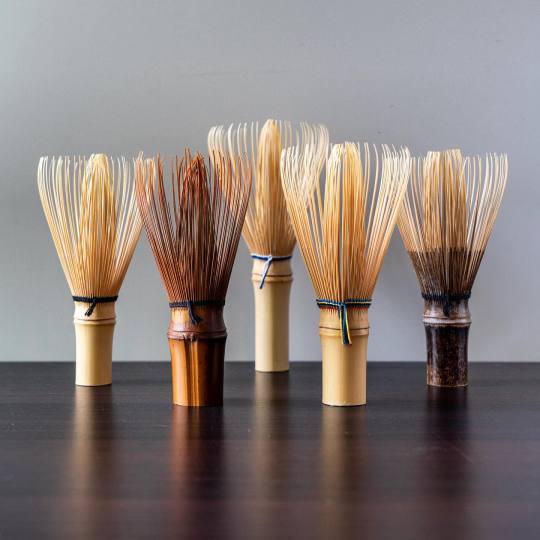
Unlike mass-produced matcha whisks, Takayama chasen are entirely handmade, without the use of machines or chemicals, elevating their craft to the level of art rather than simply being practical tools 🍵 — view on Instagram https://ift.tt/3eBlR9F
14 notes
·
View notes
Text
Matcha tea bamboo whisk - Chasen
They say 95% of made in Japan matcha tea whisk, which is called chasen (茶筅)is made in Takayama of Ikoma city in Nara prefecture and they say there are about 20 craftsmen making these whisks.
The proper made in Japan bamboo whisks are made with those bamboo which is dried slowly for over 10 years , so it takes more than 10 years to make one whisk, but the price of whisk has remained very…

View On WordPress
0 notes
Text
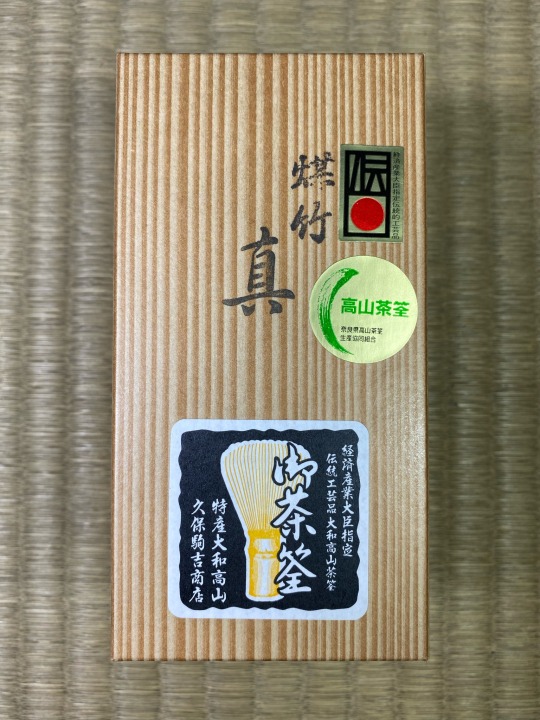

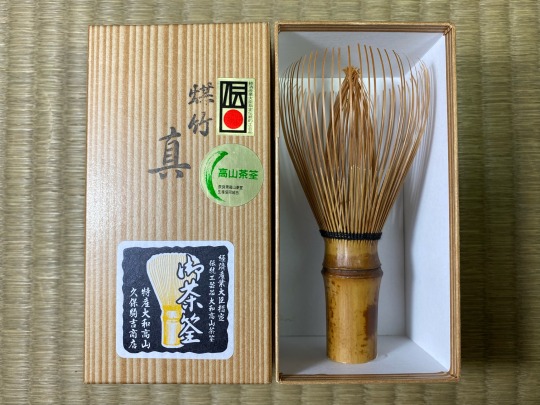
Susudake Shin chasen (煤竹 真 茶筅) 13,200THB
Crafter : Kubo Komokichi (久保駒吉)
Brand : Kubo Komakichi Shōten (久保駒吉商店)
Area : Takayama district, Ikoma city, Nara pref.
งานแปรงไม้ไผ่จากไผ่ซุซุดาเกะหรือไผ่รมควัน สีของไผ่ชนิดเกิดจากคราบควันสะสมของเตาฟืนในห้องครัวของบ้านไม้โบราณอายุนับร้อยปีในญี่ปุ่น ปัจจุบันแทบจะไม่มีการรื้อถอนบ้านไม้โบราณอีกแล้ว ทำให้ไผ่ซุซุดาเกะเป็นของหายากและมีราคาแพงมากเมื่อเทียบกับไม้ไผ่ทั่วไป ถือเป็นของหายากและส่วนใหญ่มักถูกนำมาใช้เป็นของประดับบ้านมากกว่าจะเอามาใช้จริง
1 note
·
View note
Text
Nampō Roku, Book 7 (10): the Biographies of Nambō Sōkei's Contemporaries (4): Seta no Kamon [瀬田ノ掃部].

10) Seta no kamon¹ is a very eccentric person² who is, nevertheless, extraordinarily skillful in [the exercise of his] harataki³. Time and again, his doings surprise the eyes of the people⁴.
His creativity, nevertheless, tends toward [what some consider] excesses; but there is never anything that could be described as brooding or melancholic about [all that he does]⁵.
_________________________
¹Seta no kamon [勢田ノ掃部].
Seta no kamon [勢田ノ掃部]: this is a curious and, frankly, inexplicable mistake -- since the man’s family name was Seta [瀬田]. While it is possible that Nambō Sōkei had been misinformed, or made a clerical mistake, it is easier to believe that the Edo period impostor who inserted this entry into Book Seven of the Nampō Roku simply did not know the details of the person to whom this passage was referring* (Seta kamon died, in ignominy, in 1595†).
The man known (especially in the context of chanoyu scholarship) as Seta kamon [瀬田掃部] was actually named Seta Masatada [瀬田正忠; 1548? ~ 1595].
Seta Masatada was an official in the kamon-ryō [掃部寮], which was the department charged with the upkeep and repair of the Imperial Palace (he was appointed to this position by Hideyoshi, after the latter was elevated to kampaku [關白], the chief adviser to the Emperor who also functioned as his premier and regent -- under whose purview came all of the various ministries and bureaux). He was interested in chanoyu, studied (at least for a time) with Rikyū‡, and seems to have been introduced to Hideyoshi by the daimyō Takayama Shigetomo [高山重友; 1552 ~ 1615] (better known, in the context of chanoyu scholarship, as Takayama ukon [高山右近], ukon referring to his having been the commander of the right branch of the imperial guards, the ukonoefu [右近衛府]**). Masatada is often included in the list of Rikyū's seven disciples (Rikyū shichi tetsu [利休七哲]) as Seta kamon.
On account of his service in the kamon-ryō, Masatada had access to the various apartments within the palace, and became friendly with certain of their inmates. It was through this connection that he was able to assemble a collection of antique tea utensils that had formerly been used on the numerous o-chanoyu-dana [御茶湯棚] that were attached to the various reception and sitting rooms within the palace††. As these utensils were generally of large size, his chashaku, hishaku, and chasen were equally large‡‡.
Because of his close connection with Toyotomi Hidetsugu [豊臣秀次; 1568 ~ 1595], the adopted son of Hideyoshi, he was ordered to commit seppuku along with Hidetsugu’s other associates (in 1595).
Nevertheless, it is not entirely clear why his was included in this small collection of biographies. In fact, aside from his use of the large utensils from the o-chanoyu-dana, and the modifications to the basic temae that things of that sort would require, nothing else that has come down to us about Seta Masatada suggests that he was anywhere near as eccentric as this entry implies (elsewhere in the Nampō Roku, it is Sumiyoshi-ya Sōmu who was singled out as being the radical iconoclast of his time, which also contradicts the way he is characterized in his biography). It is, therefore, at least possible that this (and the other biographies) is simply an Edo period work of fiction, created to fulfill some specific purpose (even though the author’s purpose has not yet been made clear to us***).
___________
*There was a historical person known as Seta kamon-no-suke [勢田掃部助; dates and other personal information, including his actual name, are unknown] (of which Seta kamon [勢田掃部] would have been an acceptable abbreviation). He, however, was active during the early thirteenth century, and was what we would call a hydraulic engineer. (He is remembered in history because he was successfully charged with developing a plan to control the flooding of the Kamo river -- which, up to that time, frequently overflowed, with fatal consequences to the population living downstream.)
The confusion in names might suggest the hand of a government bureaucrat in the preparation of this entry (since part of their job was to become acquainted with the associated historical precedents).
†This was because of his close connection with Toyotomi Hidetsugu, Hideyoshi’s adopted son (who was eliminated, along with all of his family, and his adherents and colleagues, once the birth of a natural son made him superfluous -- other reasons being simply pretexts, intended to save Hideyoshi face).
‡Though when this connection between Rikyū and Masatada began, and to what extent it, is not clear from the surviving historical records.
Seta Masatada was a follower of Nobunaga, and possibly became interested in chanoyu from that time -- though the large-sized utensils with which his name is usually associated could not have entered his collection before his appointment to the kamon-ryō (circa 1585).
**The men on this list were those who were permitted (by Hideyoshi) to learn the gokushin-temae. On account of the feeling of power that this temae engenders in the host (when all of the utensils are of the proper size and arranged just right), only those vassals whom Hideyoshi trusted absolutely were given permission to study this temae from Rikyū (beginning in 1586).
For this reason, the Rikyū shichi tetsu are also known as the Rikyū daisu shichi-nin-shū [利休臺子七人衆]. There are different versions of this list.
According to one such, the seven names are Gamo Ujisato [蒲生氏郷; 1556 ~ 1595], Takayama ukon Shigetomo [高山 右近 重友; 1552 ~ 1615], Hosokawa Tadaoki [細川忠興; 1563 ~ 1646], Shibayama kemmotsu Munetsuna [芝山 監物 監物; dates unknown], Seta kamon Masatada [瀬田掃部正忠; 1548 ~ 1595], Makimura heibu Toshisada [牧村兵部利貞; 1545 ~ 1593], Furuta oribe Shigenari [古田織部重然; 1544 ~ 1615]. Other versions include Hideyoshi's adopted son Toyotomi Hidetsugu [豊臣秀次; 1568 ~ 1595], and his deputy Kimura Hitachi-no-suke Shigekore [木村常陸介重茲; ? ~ 1595], while eliminating two of the others.
Nevertheless, in Shigekore’s case at least, Rikyū appears to have refused to give him instruction in this most secret temae (according to a statement to that effect that forms part of the densho that Rikyū addressed to the vice-governor of Hitachi -- though the fact that the document, which linguistically dates from the middle of the 1580s, does not contain the year allows for the possibility that Rikyū may have changed his mind, if permission had eventually been received from Hideyoshi).
††With the increasing popularity of chanoyu, with the tea prepared at a daisu in the guests’ presence, the use of the o-chanoyu-dana fell out of use, with its utensils (primarily the furo, kama, mizusashi, and very large taikai-chaire) left to decay in storage (because most of these things were considered much too large to be used in any other setting, according to the preferences of the day, Seta Masatada was able to get his hands on them without difficulty).
The reason why his hishaku and chashaku were as large as they are was so that they would be in proportion to the other utensils with which they were used. Masatada’s hishaku survives today as the ordinary ro-yō hishaku [爐用柄杓] -- though Seta kamon naturally used it all year round (as was the custom), regardless of whether he was serving tea with the ro, or with the furo.
‡‡Seta Masatada owned a very large chawan, known (in the Nampō Roku) as the sui-kai chawan [水海 茶碗]. It was unusually shallow (more like a Western “pasta dish” than what we would consider a bowl); and was 15-me [目] (about 7-sun 5-bu, or 22.7 cm) in diameter.

This bowl was mentioned in Book Five, Part 13, in the post entitled Nampō Roku, Book 5 (13.1): the Arrangement [of the Daisu] During the Shoza when [Receiving a] Respected Guest, Part 1. The URL for which is: https://chanoyu-to-wa.tumblr.com/post/620572177833623553/namp%C5%8D-roku-book-5-131-the-arrangement-of
This chawan, and its use, will also be discussed a little later in Book Seven (in entries 15, 16, and 17).
***Shibayama Fugen, in his very brief notes on this biography, lays out the hypothesis that the first four chajin were included in this list because each of them epitomizes one of the virtues (that the author of the essays deemed to be) necessary for the consummate master. About this he writes, “art takes on different forms, depending on each person's disposition and personality. All of these men were masters of their time, each with his own unique strengths and weaknesses. We can look at [them] in this way:
◦ [Tennōji-ya] Sōkyū’s [hataraki] is far-reaching and perspicacious;
◦ [Sumiyoshi-ya] Sōmu’s [hataraki] is moderate and modest;
◦ [Naya] Sōkyū’s [hataraki] is founded on an outstanding technique; and,
◦ [Seta no] kamon’s [hataraki] is unconventional, and supremely brilliant.”
His argument, then, seems to be that, whereas each of these masters embodies one aspect of mastery, only in Rikyū (who will be the subject of the next and final biography) are all four of these attributes gathered together in one individual.
²Hanahada ki-i no hito ni te [甚奇異ノ人ニテ].
Hanahada [甚だ] means very much, greatly, exceedingly -- and (perhaps) to excess.
Ki-i no hito [奇異の人] means an eccentric (or even bizarre) person.
The language in this entire entry is often improbably exaggerated, marking it as a product of the Edo period. Many expressions are so uncommon that their exact meaning can only be guessed at.
³Tobi-kittaru hataraki domo [トビ切タルハタラキドモ].
Shibayama Fugen and Tanaka Senshō both have this and the next phrases punctuated differently. For this sentence, they have tobi-kittaru hataraki domo tabi-tabi ari [トビ切タルハタラキドモタビ〰アリ].
Tobi-kittaru hataraki [飛び切たる働き] means that Masatada’s hataraki is finished, complete, fully realized.
Tabi-tabi ari [度々あり] means often exists.
In other words, Seta kamon frequently demonstrates a truly remarkable, masterful hataraki -- his hataraki leaves nothing to be desired.
⁴Tabi-tabi hito-bito mo me wo odorokasu to iedomo [タビ〰人〻モ目ヲ驚カストイヘドモ].
Again, both Shibayama and Tanaka distribute the words into phrases slightly differently from what is seen in the Enkaku-ji manuscript*: hito-bito mo me wo odorokasu to iedomo [人〻モ目ヲ驚カストイヘドモ].
Hito-bito [人々] means people, the interested public, people in general.
Me wo odorokasu [目を驚かす] means (their) eyes are surprised -- that is, the people are surprised (by what Seta kamon does).
___________
*At least as the text is given in the Sadō Ko-ten Zen-shū [茶道古典全集] edition of the Nampo Roku.
⁵Amari tobi-sugite shushō ni shimeyaka-naru-koto nashi [アマリ飛過テ殊勝ニシメヤカナルコトナシ].
Amari [余り] means really -- though it also includes the nuance of going to excess, doing something to a fault, doing too much.
Tobi-sugite [飛び過ぎて] means to fly beyond, to exceed, to surpass.
Shushō ni [殊勝に] means commendability, worthy of being praised.
Shimeyaka-naru-koto nashi [沈寂なること無し]: the case (koto [こと]) of being or becoming (naru [なる]) gloomy* (shimeyaka [蕭條]); (this situation) does not exist (nashi [無し]).
In other words, Seta Masatada’s hataraki goes beyond mere complements, since it is always positive.
However, according to Tanaka Senshō, the original version† of this final sentence was tobi-sugite kuwashiku omoiiri-taru-koto sukunashi [飛過テ委ク思入タルコト少ナシ]. This means, “if [one] soars too high, it seems as if [one] has not thought about [things] in minute detail.”
__________
*This is “quiet” in the negative sense of there being no traces of human presence, hence the setting or situation has fallen into a lonely and depressed state, overshadowed with a feeling of desolation; the word also includes the nuance of foreboding, of impending doom.
When used of a person, it indicates someone with a mournful or melancholic personality. Here (due to the final nashi [無し]), it means that Seta kamon is never gloomy or melancholic.
Historically, the word has also been written with the kanji combinations “蕭索,” “蕭然,” and “沈寂” -- though none of them (including the one given above in the body of this footnote) is actually pronounced shimeyaka (so some prefer to render it exclusively with kana, as しめやか).
†In a document that he rather vaguely refers to as the genpon [原本] (“original book”) -- which, presumably, was “lost” when the Japanese Imperial Army burned down the Shū-un-an early in the last century (while at least part of Nambō Sōkei’s hoard of papers is hidden away in a certain school’s secret archives -- based on what I saw with my own eyes -- it is not clear how Tanaka would have known about the contents of this material, which was still a jumbled stack of random papers in the late 70s, or how he may have gained access to it).
Or perhaps he means Tachibana Jitsuzan’s original notes (which were later edited into the Nampō Roku for presentation to the Enkaku-ji)?
1 note
·
View note
Photo

Visited Takayama in Nara with #puddinglaboratory , the home of chasen (茶筌, tea whisk), to meet Mr. Tanimura the artisan and worker of chasen. . Have you ever drunk #matcha at a real #tea #ceremony? I am a #master of #Japanese #zen #teaceremony who have already entertained over 3000 guests through my 28 years experience. I am also only one professional provider of #private tea ceremony for #traveller. When you visit Japan and wish a special #travel #experience of the deepest Japanese #traditional #culture, you got to DM me or you will miss the biggest chance to have a great experience. I will take you back with me to the 500 years #history of Japan by entertaining you with beautiful #antique #luxury tea ware, #stunning taste #kaiseki, and #rich taste of matcha in beautiful tea room. (Japanese Luxury tea ceremony - Chabito)
#travel#luxury#kaiseki#traveller#history#master#private#zen#ceremony#stunning#puddinglaboratory#matcha#teaceremony#culture#traditional#antique#experience#tea#rich#japanese
1 note
·
View note
Photo

This photo from Nara, Japan, shows bamboo being sun-dried for use in making tea whisks (茶筅, chasen) for preparing matcha during the Japanese Tea Ceremony. The Nara region is famous for growing bamboo and producing these implements, and these arrangements are a common sight in the Takayama area of Ikoma, Nara, from late winter to early spring.
Photo © Degueulasse (Wikimedia Commons), CC BY 3.0.
4 notes
·
View notes
Video
youtube
手技TEWAZA「高山茶筌」Takayama tea whisk
La fabrication du chasen n'aura plus de secret pour vous…
…pour fouetter votre thé matcha à la perfection
http://www.neo-t.fr/fr/4011-cha-no-yu
0 notes
Text


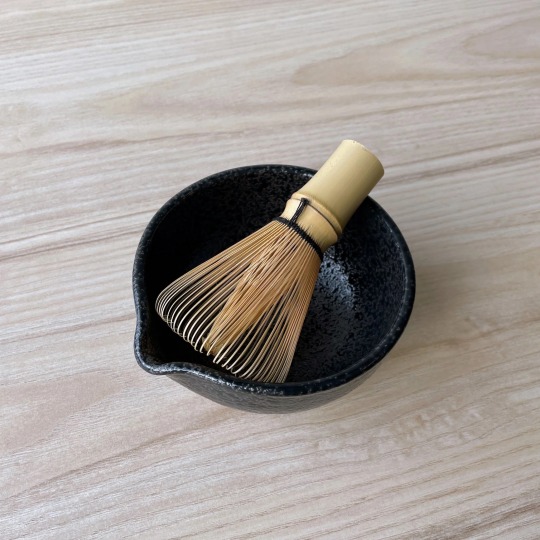
#bamboo whisk#takayama chasen#matcha whisk#tea whisk#chasen#tea#matcha#hojicha#takayama#nara#made in japan#bamboo#chado
5 notes
·
View notes
Photo

Back in the shop 🖤
Handcrafted from black bamboo, the Hojicha Whisk (Takayama Chasen) is available again in our teaware section.
hojicha.co/teaware
#chasen#bamboo whisk#hojicha whisk#takayama chasen#black bamboo#bamboo#made in japan#takayama#nara#japan#hojicha co.
6 notes
·
View notes
Photo


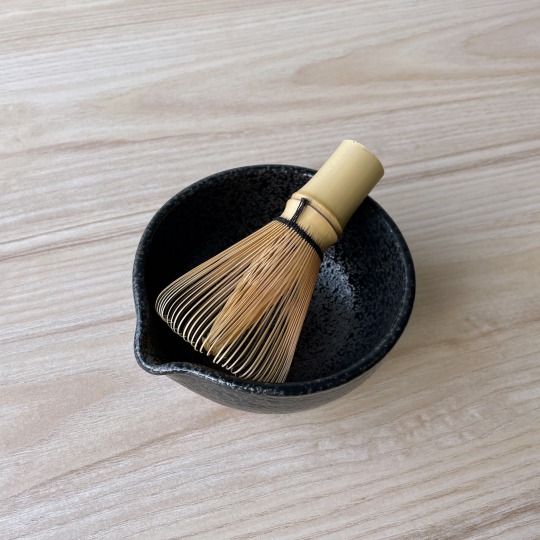
Bamboo Whisk (Takayama Chasen)
The Bamboo Whisk is a handcrafted tea utensil designed for the preparation of Japanese tea powder. It is an indispensable tool in the Japanese way of tea.
https://hojicha.co/products/bamboo-whisk
#takayama chasen#matcha whisk#bamboo whisk#tea whisk#chasen#tea#matcha#hojicha green tea#teaware#made in japan#handcrafted#artisanal#crafts#takayama#nara#japan
8 notes
·
View notes
Text
Hojicha Whisk 🖤
This Takayama Chasen is handcrafted by 25th generation chasen master Yasaburo Tanimura using a technique that has been perfected for over 500 years.
Each black bamboo whisk features a striking bright red thread, and comes in a box with a stamp of authenticity issued by Japan's Traditional Craft Industry Promotion Association.
When you whisk tea with a Takayama Chasen, you are helping to keep the ancient tradition alive and will feel the care and dedication it took to patiently shape the natural bamboo into an artisanal tea utensil.
https://hojicha.co/products/hojicha-whisk
#chasen#takayama#nara#takayamachasen#bamboowhisk#teawhisk#matchawhisk#bamboo#blackbamboo#matcha#hojicha#japanesetea#tea#teaware#chado#chanoyu#handcrafted#madeinjapan#japanesecraft#japanesecraftmanship#japan#homecafe#おうちカフェ#茶筌#茶筅#抹茶#日本#工芸品#伝統工芸
12 notes
·
View notes
Text
A handcrafted Takayama Chasen (bamboo whisk) is a precious tea utensil.
Proper care and storage can help extend the life of the bamboo whisk.
The best way to store the bamboo whisk is on a naoshi (whisk holder) in a well-ventilated area.
The naoshi protects the natural bamboo and helps the bristles maintain their shape as they dry.
#takayamachasen#chasen#bamboowhisk#teawhisk#matchawhisk#takayama#nara#teaware#madeinjapan#handcrafted#chasennaoshi#matcha#hojicha#tea#japanesetea#japaneseteaware#ceramics#tenmoku#pottery#japanesepottery#japaneseceramics#茶筌#茶筅#高山茶筌#高山茶筅#茶道#抹茶
10 notes
·
View notes
Video
How to Use a Takayama Chasen
Takayama Chasen are built to last, but proper care is required to preserve the natural bamboo.
Before using a chasen to whisk powdered tea, the bristles need to be softened in hot water. Immerse the bristles in a bowl of hot water, and gently move the whisk for a few seconds without pressing the whisk against the bottom or sides of the bowl. This step makes the bristles flexible enough to whisk the tea well and prevents the tips from breaking.
While whisking the tea, the chasen should barely touch the tea bowl as excessive downwards pressure will damage the bristles. When whisking is complete, the chasen should be carefully extracted with the bristles facing up. This will also remove the temptation to shake or tap the bamboo whisk against the side of the bowl.
https://hojicha.co/pages/takayama-chasen
#takayama#chasen#hojicha#whisk#japanese tea#matcha#matcha whisk#bamboo whisk#teaware#japanese teaware#japan#made in japan#handcrafted#tea#green tea#hojicha powder#hojicha tea#matcha tea#hojicha co.
19 notes
·
View notes
Video
Hojicha Affogato
🍵 Hojicha Powder (@hojicha-co)
💦 80°C water
🍦 Vanilla ice cream
🍪 Lotus Biscoff cookie
https://hojicha.co/blogs/recipes/hojicha-affogato
#hojicha#affogato#food#recipe#hojicha co.#hojicha powder#japanese tea#tea#green tea#houjicha#hojicha tea#katakuchi#teaware#takayama chasen#home cafe#home barista#ice cream#hojicha.co#foodie#japanese food#japan#kyoto#made in japan
10 notes
·
View notes
Link
0 notes